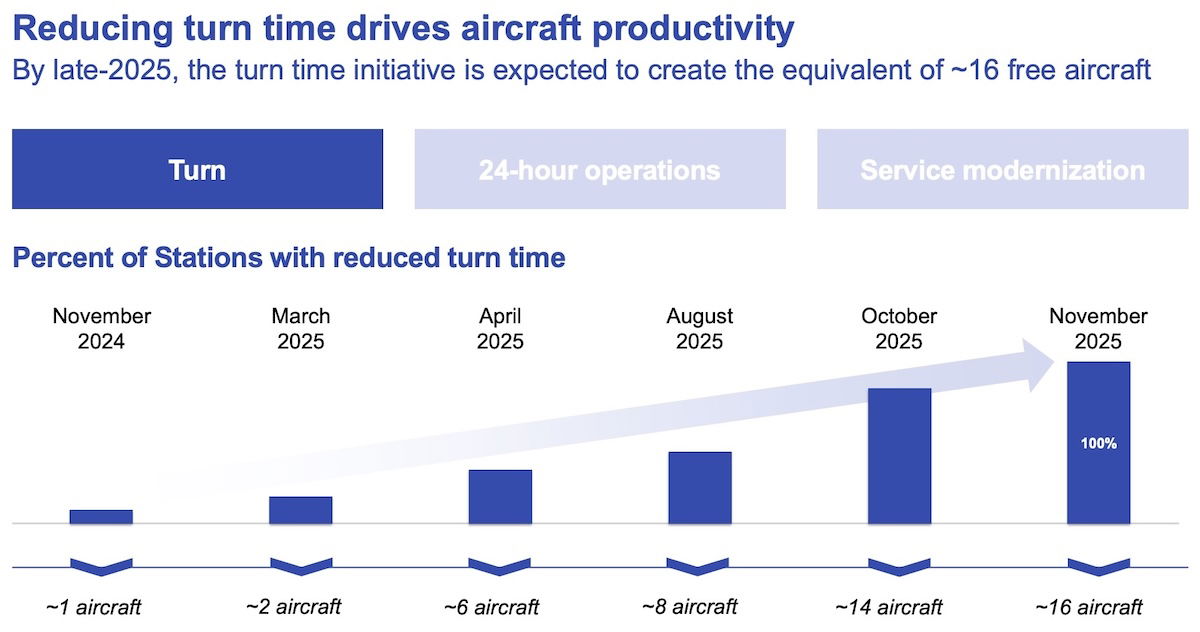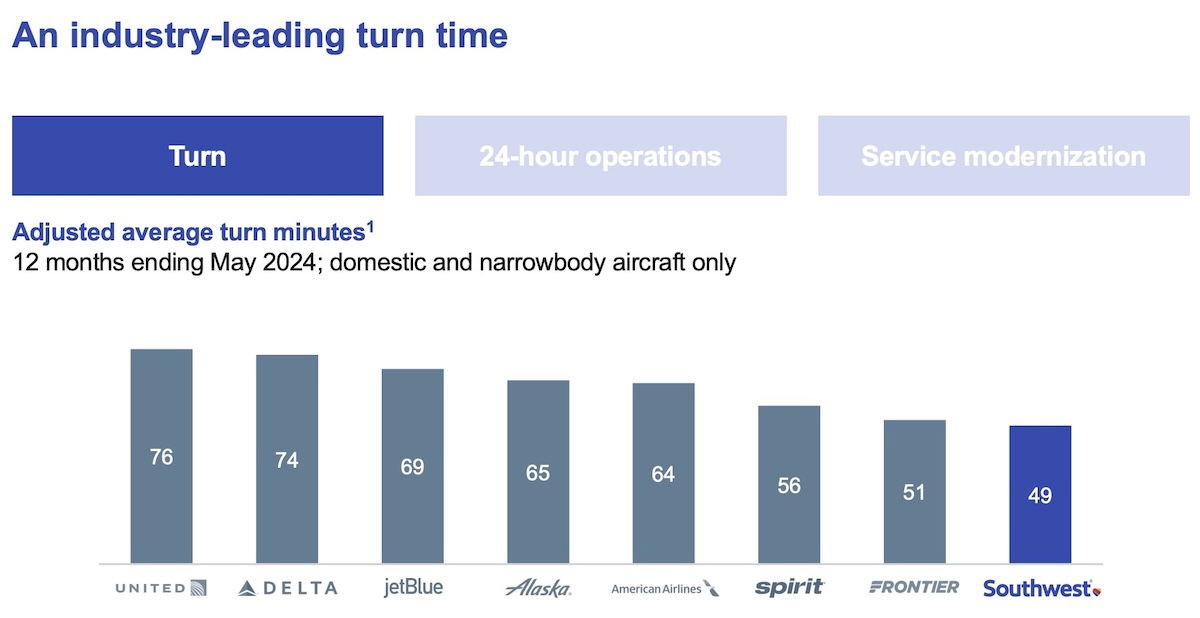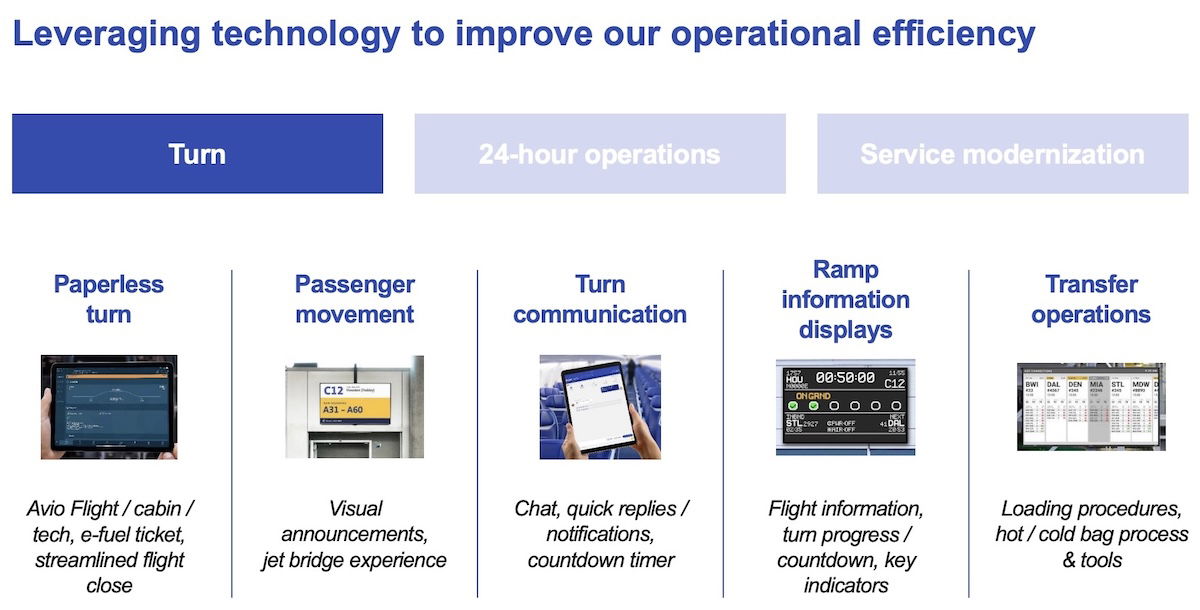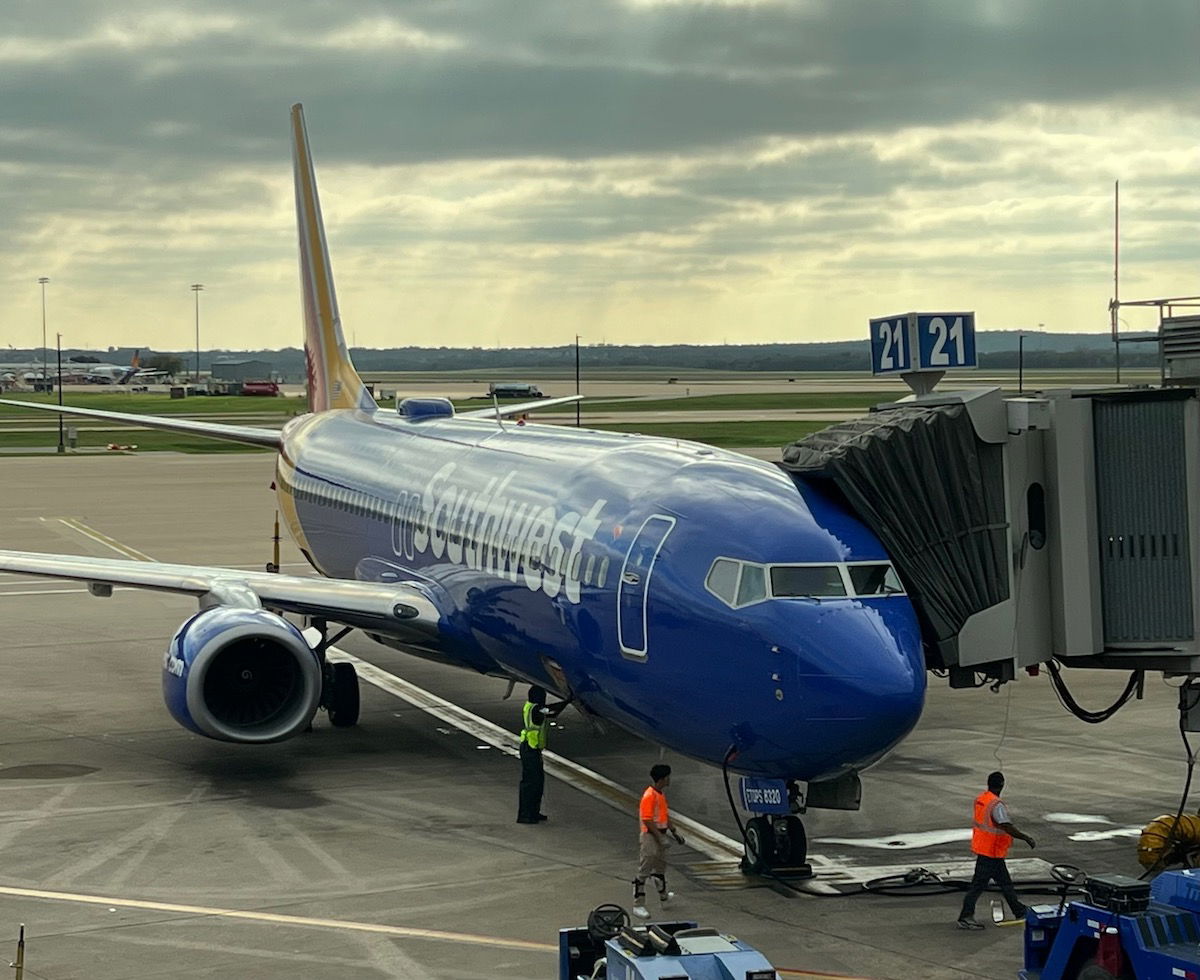Southwest is currently evolving its business model, given the carrier’s lagging financial performance, plus pressure from activist investors. We know some of the major changes that the airline plans to make, like adding preferred and extra legroom seating, and introducing redeye flights.
However, what I haven’t covered up until now is possibly the strangest part of the carrier’s transformation plan, which was revealed during the recent Investor Day event. Specifically, the airline wants to reduce turn times by five minutes, and claims that will free up the equivalent of 16 aircraft.
Is this brilliant, or is Southwest grasping at straws here, and even a bit unrealistic? Cranky Flier covered this a few days ago, and I find it to be fascinating…
In this post:
How Southwest plans to improve operational efficiency
Southwest prides itself in operational efficiency. Back in the day, the airline was known for its 25-minute turns, thanks to its open seating policy, no checked bag fees, and relatively small planes.
However, those days are long gone, and currently Southwest’s average turn times are roughly twice as long. This is at least in part because Southwest also flies larger Boeing 737 variants than in the past, so there are more people to deplane and board.
With Southwest trying to improve its economics, the airline is once again sees turn times as an opportunity. Specifically, the goal is to shave five minutes off of each aircraft turn, and if implemented correctly, the airline argues that this would free up the equivalent of 16 aircraft.

The challenge is that Southwest already has the best turn time in the industry, so can the airline go from best to even better? Southwest currently has an average of a 49-minute turn time, but the airline wants to reduce that to 44 minutes. This is way faster than the competition, though in fairness, the competition also flies planes that (on average) have more seats.
The legacy carriers fly wide body aircraft, while airlines like Frontier and Spirit also fly some more densely configured narrow body aircraft.

Wanting to reduce turn times is fair enough, but how does Southwest plan to accomplish that?
- The airline wants to go paperless on turns, so crews no longer have to wait on paperwork from ground agents, but rather the “paperwork” can be sent electronically to their tablets
- The airline wants to speed up passenger movement with “visual announcements,” and a “jet bridge experience” that includes playing fast-paced music to keep people moving
- The airline wants to improve communication between various employee groups, so that ramp agents, gate agents, flight attendants, and pilots, can communicate more efficiently with one another through a chat feature
- The airline wants to install ramp information displays, so that all employees are on the same page about how much time is remaining until the expected departure, etc.
- The airline wants to change how it goes about loading bags, so that those bags that need to make connections are loaded last, and therefore are unloaded first, avoiding additional delays

To Southwest’s credit, the airline is taking a very gradual approach to this change, and will be trialing this at some stations before fully implementing it. So this won’t be some operational disaster, because the airline can quickly backtrack with this plan if it doesn’t work out.
My take on Southwest’s efficiency initiative
On the one hand, I can’t help but sort of laugh that activist investors are trying to oust Southwest’s management, and rather than charging for checked bags or doing something radical, Southwest management instead comes up with the idea of reducing turn times by five minutes, by… *checks notes* playing fast-paced music in the jet bridge, among other things.
On the other hand, this does sound great on paper, and to investors. “Hey, we’re going to increase efficiency, and it’ll be the equivalent of adding 16 aircraft to our fleet.” I mean, who doesn’t want the equivalent of 16 extra planes, without actually having to acquire any planes?
However, there’s just so much here to unpack. First of all, it’s amazing how behind the times Southwest is with technology. The concept of ramp information displays and communication between crew members is something we’ve seen at other airlines for a long time, so Southwest is just playing catch up here.
Next, I’m curious about how exactly Southwest comes up with this freeing up 16 additional planes. Historically, the number of hours in the day hasn’t really been much of a consideration in Southwest’s strategy, given that the airline elected not to operate redeye flights, so all Southwest planes sat on the ground for many hours each day.
If an aircraft operates an average of five flights per day, and if you reduce turn times by five minutes, that frees up an extra 25 minutes. That’s not enough to operate an extra flight, so I assume the idea is that this increased efficiency would just allow the airline to completely reshuffle its schedule and fleet planning, and eventually sequence planes differently?
But all of this raises the question of what the limit is to how efficiently you can turn an aircraft when the variable is the American traveling public. Like, we’re not Japan, where you can board a full 777 in 20 minutes, because everyone listens and is considerate of others. I think the only thing that could actually materially speed up turn times would be boarding through both forward and rear doors (as we see at some European airlines), but most US airports aren’t really set up for that.
I also find it interesting how this change is being made around the same time that Southwest is transitioning to assigned seating. I’d be surprised if Southwest can maintain its current turn times, let alone improve them, while moving to assigned seating. The open seating sort of becomes a big game of musical chairs, and that probably helps with efficiency.
The last thing is that the tighter you schedule turns, the less buffer there is when there’s any sort of a delay, even if it has nothing to do with boarding. Southwest planes operate several flights per day, and one wonders if there will be a tradeoff between shorter turn times and operational reliability.

Bottom line
Southwest is hoping to reduce turn times by five minutes, from 49 minutes to 44 minutes. The airline has a variety of strategies to accomplish this, ranging from catching up to the competition with technology, to playing fast-paced music in the jet bridge.
Southwest already has the industry’s fastest turn times, and I question how realistic this goal is, especially with the airline also moving to assigned seating. Do you think Southwest can really get the average down to 44 minutes?
What do you make of Southwest’s goal of reducing turn times?





The idea that music in the jet bridge makes us go faster is funny. The only reason I'm ever slow on the jet bridge is because there's a bottleneck of people boarding the plane.
IIRC, the SW jets in the 70's & 80's were did not carry as many passengers as today. Also, did not have as many "Jesus Jetway" and wheelchair crowd as today. On my last two Southwest flights, I got hit the "reserved seating" BS as well. Not a big fan of assigned seating, but SW brought this on themselves. Could have resolved the issue with a simple announce of, "Please take the first seat available,...
IIRC, the SW jets in the 70's & 80's were did not carry as many passengers as today. Also, did not have as many "Jesus Jetway" and wheelchair crowd as today. On my last two Southwest flights, I got hit the "reserved seating" BS as well. Not a big fan of assigned seating, but SW brought this on themselves. Could have resolved the issue with a simple announce of, "Please take the first seat available, no seats are reserved." But management turned a blind eye!!
As for the number of turn arounds that are projected, realize the clock starts anew each day. You can squeeze in another flight or two, but that's the limit unless you do red eye flights across the fleet. WN will be flying half empty jets in the middle of the night just to justify an obscure metric. Don't forget the ground crew that will be getting OT waiting for the jet to arrive at 4 AM.
Also, if the turnarounds are too tight (which WN experimented with years ago), the whole system falls apart with a snow storm or hurricane like Milton which will be visiting Florida this coming Wednesday. Another item to consider, has WN really gotten its act together assigning crew members to flights in adverse weather conditions? Time will tell.
As related to me by a college professor, "Be careful of false prophets (ie: efficiency experts), for their advise only work in a perfect world!!"
This writer does not have a grasp on the potential savings. Over 3000 flights perday, if 5 minutes were saved on each, that amount of daily time could easily equate to many more aircraft in the schedule. On the other hand, assigned seating will likely slow down everything.
The only way to speed up turn times are number one not allow bigger carry ons (or charge to bring them on) and two cut down on the fake wheelchairs (and the ten people that board with each wheelchair) by requiring a doctor's order. Otherwise, with a full load it's impossible. Unless the gate boards wheelchairs early which then defeats the idea of quicker allotted turn times.
If Southwest devises their new boarding process properly (ie, such that they prioritize efficiency over elites and extra legroom buy ups needing to feel special) they probably can accomplish this. If you have ever boarded an aircraft in Japan, you know that if to rigidly stick to the back to front, window to aisle boarding method, which means business and extra legroom seats board last, you can board a dense widebody shockingly fast.
The disconnect between corporate and front line employees.
Credits to the Wallstreet leeches who brought you TWA.
Elliott, as a matter of fact, actually put money into TWA during Icahn era.
SWA is the new TWA.
All changes are positive they say.
I worked for Southwest Airlines back in the day for 26 years and we had 10 minute turns not 25 minute turns because it was a 50 minute flight between San Antonio Houston and Dallas and we did 10 minute turns all the time in the 80s!
Paul Singer is not going to be impressed with 44 minute turns. He has lots of money and wants to make a big score. He’s betting he knows who’s going to win the election and what that will mean for future industry consolidation. Now what airline would fit with Southwest? What airline would Southwest’s employees want to work for if they were forced to merge with another carrier? What airline could easily obtain the financing...
Paul Singer is not going to be impressed with 44 minute turns. He has lots of money and wants to make a big score. He’s betting he knows who’s going to win the election and what that will mean for future industry consolidation. Now what airline would fit with Southwest? What airline would Southwest’s employees want to work for if they were forced to merge with another carrier? What airline could easily obtain the financing needed to pull off such a deal? What airline just added even more service out of Austin and what city did Southwest just drastically reduce service? Assigned seats… 44 minute turns…these are just a smoke screen. The stage is being set for a much bigger change.
"Back in the day ...." SW did 10 MINUTE!! turns. It first flew in the early 70's with 3 737's, couldn't afford one of them, were getting ready to gut the schedule, employees went to Lamar Muse, who has never been given proper credit for launching SW, "We can maintain the schedule if we do 10-minute turns." And for years they did! And try to imagine today's employees doing that to save the airline!
Frontier achieved a 51 minute turn with assigned seating and while operating A321neos in a dense seating configuration, so Southwest should be able to achieve 44 minutes with their 737 fleet. The key to Frontier & Spirit is limiting the amount of carry on bags. I disagree with ULCC for charging for everything, but I actually think it makes sense for Southwest to discourage carry on bags if they are keeping 2 free checked bags.
The only thing slowing down boarding besides preboards and wheelchairs is carry on bags! Most airlines have strict rules on amount and sizes allowed and actually enforce it before you get to board. Southwest used to do 10 minute turns back in the day before roller bags.
It's easy to turn a plane if you put minimal effort into cleaning it. I like SW but their planes are dirty AF. Consistently.
True statement because Southwest refuses to have cleaners like every other airline. $$
I really am not convinced that open seating helps with faster turn times. In my experience on Southwest, on any remotely full flight, once everyone is boarded, we then spend 15 minutes while the flight attendants try to arrange seat swaps in order to seat families with children and couples together. Lots of announcements looking for volunteers. Assigned seating would just make the whole thing much more efficient.
We've been flying Southwest fairly often and have never seen any delays due to seat swaps or heard anything about volunteers.
I think boarding isn't a problem as much as deplanning. Some rows get up and move off the plane quickly and others its like they have no clue what is going on, where their luggage is on the plane, etc. We were in row 17 last night and it seemed like forever to get off the plane.
Carry-on bags are the biggest factor. That's why boarding AND deplaning are so much quicker in Japan and some other Asian countries, where most passengers check their bags (including carry-on bags). WN could easily achieve their target turnaround time if it put some limit on carry-ons. Not only it has the most generous checked bag policy, but it also has the most generous (in terms of size limit) carry-on policy.
We've been flying southwest frequently due to the companion pass. Last night was the first time we had an on time departure/arrival. They seem to have a lot of issues getting crews to the aircraft, often delayed on arriving flights.
Charging for bags makes zero sense unless they will reduce airfares because the AFs are higher than competitors so the bags are kind of already priced in. Seat selection is a necessity.
If every plane wraps its day 25-minutes early, that is a lot of hours the company can save over a year in personnel costs.
With that said, yes make the tech improvements, but I fail to see how fast music on the jet bridge speeds up boarding. The bottle neck is the narrow aisle on their ever increasing capacity planes.
They used to have great boarding times as they were flying significantly less...
If every plane wraps its day 25-minutes early, that is a lot of hours the company can save over a year in personnel costs.
With that said, yes make the tech improvements, but I fail to see how fast music on the jet bridge speeds up boarding. The bottle neck is the narrow aisle on their ever increasing capacity planes.
They used to have great boarding times as they were flying significantly less passengers and concepts like rear stairs (which you can still find at places like BUR) were more common during the era were not every gate was a jet bridge.
The biggest thing that WN has in it's favor for quicker turns at this point, compared to the competition, is the fact they still let folks check bags for free which means fewer people slowing down the process putting bags in bins and then having to backtrack to seats. I think assigned seating will likely make this issue worse if anything in terms of congestion while boarding.
A few months ago we flew SWA out of Long Beach, where they board and deplane via the front and the back. It was eye opening how quickly a 737-700 can empty out and reload that way, with the only real slow down waiting for a couple of wheelchairs (there is a ramp in the front, stairs are used in the rear).
As soon as Southwest implements assigned seating and there are 50 fewer wheelchair passengers boarding each flight, turn times should improve exponentially.
Southwest has already been an OTP disaster later in the day with their already tight turns.
The key issue to the delays…..fake wheelchair passengers…..anytime you see an aircraft go through PHX or LAS. It’s a wheelchair parade that takes a lot of resources to get down the jetbridge. I would implement the assigned seating first….then assess the turn times.
The main, and probably only, reason why Southwest has much faster turns than the completion is that bags fly free on Southwest. Full stop.
People with carry-ons to stow and pick up at the other end slow down boarding and deplaning tremendously, especially the old ladies on a leisure trip who would have rather checked their bags if not for the predatory fee.
No free bags on Ryanair and their turn time is 25 minutes. Boarding front and rear seems to be the solution.